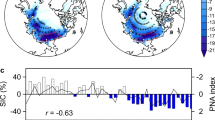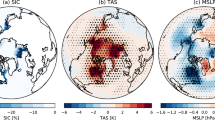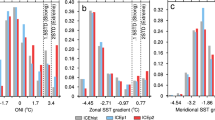Abstract
Annual minima in Arctic sea-ice extent and volume have been decreasing rapidly since the late 1970s, with substantial interannual variability. Summers with a particularly strong reduction of Arctic sea-ice extent are characterized by anticyclonic circulation anomalies from the surface to the upper troposphere. Here, we investigate the origin of these seasonal circulation anomalies by identifying individual Arctic anticyclones (with a lifetime of typically ten days) and analysing the air mass transport into these systems. We reveal that these episodic upper-level induced Arctic anticyclones are relevant for generating seasonal circulation anomalies. Sea-ice reduction is systematically enhanced during the transient episodes with Arctic anticyclones and the seasonal reduction of sea-ice volume correlates with the area-averaged frequency of Arctic anticyclones poleward of 70° N (correlation coefficient of 0.57). A trajectory analysis shows that these anticyclones result from extratropical cyclones injecting extratropical air masses with low potential vorticity into the Arctic upper troposphere. Our results emphasize the fundamental role of extratropical cyclones and associated diabatic processes in establishing Arctic anticyclones and, in turn, seasonal circulation anomalies, which are of key importance for understanding the variability of summertime Arctic sea-ice melting.
This is a preview of subscription content, access via your institution
Access options
Access Nature and 54 other Nature Portfolio journals
Get Nature+, our best-value online-access subscription
$29.99 / 30 days
cancel any time
Subscribe to this journal
Receive 12 print issues and online access
$259.00 per year
only $21.58 per issue
Buy this article
- Purchase on Springer Link
- Instant access to full article PDF
Prices may be subject to local taxes which are calculated during checkout




Similar content being viewed by others
References
Simmonds, I. Comparing and contrasting the behaviour of Arctic and Antarctic sea ice over the 35 year period 1979–2013. Ann. Glaciol. 56, 18–28 (2015).
Kay, J. E., Holland, M. M. & Jahn, A. Inter-annual to multi-decadal Arctic sea ice extent trends in a warming world. Geophys. Res. Lett. 38, L15708 (2011).
Ogi, M. & Rigor, I. G. Trends in Arctic sea ice and the role of atmospheric circulation. Atmos. Sci. Lett. 14, 97–101 (2013).
Wettstein, J. J. & Deser, C. Internal variability in projections of twenty-first century Arctic sea ice loss: role of the large-scale atmospheric circulation. J. Clim. 27, 527–550 (2014).
Serreze, M. C., Stroeve, J., Barrett, A. P. & Boisvert, L. N. Summer atmospheric circulation anomalies over the Arctic Ocean and their influences on September sea ice extent: a cautionary tale. J. Geophys. Res. Atmos. 121, 11463–11485 (2016).
Stroeve, J., Hamilton, L. C., Bitz, C. M. & Blanchard-Wrigglesworth, E. Predicting September sea ice: Ensemble skill of the SEARCH Sea Ice Outlook 2008–2013. Geophys. Res. Lett. 41, 2411–2418 (2014).
Screen, J. A. & Simmonds, I. The central role of diminishing sea ice in recent Arctic temperature amplification. Nature 464, 1334–1337 (2010).
Cohen, J. et al. Recent Arctic amplification and extreme mid-latitude weather. Nat. Geosci. 7, 627–637 (2014).
Barnes, E. A., & Screen, J. A. The impact of Arctic warming on the midlatitude jet-stream: Can it? Has it? Will it?. WIREs Clim. Change 6, 277–286 (2016).
Döscher, R., Vihma, T. & Maksimovich, E. Recent advances in understanding the Arctic climate system state and change from a sea ice perspective: a review. Atmos. Chem. Phys. 14, 13571–13600 (2014).
Kay, J. E., L’Ecuyer, T., Gettelman, A., Stephens, G. & O’Dell, C. The contribution of cloud and radiation anomalies to the 2007 Arctic sea ice extent minimum. Geophys. Res. Lett. 35, L08503 (2008).
Kay, J. E. & L’Ecuyer, T. Observational constraints on Arctic Ocean clouds and radiative fluxes during the early 21st century. J. Geophys. Res. Atmos. 118, 7219–7236 (2013).
Graversen, R. G., Mauritsen, T., Drijfhout, S., Tjernström, M. & Mårtensson, S. Warm winds from the Pacific caused extensive Arctic sea-ice melt in summer 2007. Clim. Dynam. 36, 2103–2112 (2010).
Screen, J. A., Simmonds, I. & Keay, K. Dramatic interannual changes of perennial Arctic sea ice linked to abnormal summer storm activity. J. Geophys. Res. 116, D15105 (2011).
Zhang, J., Lindsay, R., Schweiger, A. & Steele, M. The impact of an intense summer cyclone on 2012 Arctic sea ice retreat. Geophys. Res. Lett. 40, 720–726 (2013).
Ogi, M. & Wallace, J. M. The role of summer surface wind anomalies in the summer Arctic sea ice extent in 2010 and 2011. Geophys. Res. Lett. 39, L09704 (2012).
Gong, T., Feldstein, S. & Lee, S. The role of downward infrared radiation in the recent Arctic winter warming trend. J. Clim. 30, 4937–4949 (2017).
Woods, C. & Caballero, R. The role of moist intrusions in winter Arctic warming and sea ice decline. J. Clim. 29, 4473–4485 (2016).
Lee, H. J. et al. Impact of poleward moisture transport from the North Pacific on the acceleration of sea ice loss in the Arctic since 2002. J. Clim. 30, 6757–6769 (2017).
Jakobson, E. & Vihma, T. Atmospheric moisture budget in the Arctic based on the ERA-40 reanalysis. Int. J. Climatol. 30, 2175–2194 (2010).
Doyle, S. H. et al. Amplified melt and flow of the Greenland ice sheet driven by late-summer cyclonic rainfall. Nat. Geosci. 8, 647–653 (2015).
Belchansky, G. I., Douglas, D. C. & Platanov, N. G. Duration of the Arctic sea ice melt season: Regional and interannual variability, 1979–2001. J. Clim. 17, 67–80 (2004).
Ding, Q. et al. Influence of high-latitude atmospheric circulation changes on summertime Arctic sea ice. Nat. Clim. Change 7, 289–296 (2017).
Kwok, R. Outflow of Arctic Ocean sea ice into the Greenland and Barents Seas: 1979–2007. J. Clim. 22, 2438–2457 (2009).
Tsukernik, M., Deser, C., Alexander, M. & Tomas, R. Atmospheric forcing of Fram Strait sea ice export: a closer look. Clim. Dynam. 35, 1349–1360 (2010).
Smedsrud, L. H., Halvorsen, M. H., Stroeve, J. C., Zhang, R. & Kloster, K. Fram Strait sea ice export variability and September Arctic sea ice extent over the last 80 years. Cryosphere 11, 65–79 (2017).
Davies, H. C. Weather chains during the 2013/2014 winter and their significance for seasonal prediction. Nat. Geosci. 8, 833–837 (2015).
Grunseich, G. & Wang, B. Arctic sea ice patterns driven by the Asian summer monsoon. J. Clim. 29, 9097–9112 (2016).
Ogi, M., Rigor, I. G., McPhee, M. G. & Wallace, J. M. Summer retreat of Arctic sea ice: role of summer winds. Geophys. Res. Lett. 35, L24701 (2008).
Watanabe, E., Wang, J., Sumi, A. & Hasumi, H. Arctic dipole anomaly and its contribution to sea ice export from the Arctic Ocean in the 20th century. Geophys. Res. Lett. 33, L23703 (2006).
Wang, J. et al. Is the dipole anomaly a major driver to record lows in Arctic summer sea ice extent? Geophys. Res. Lett. 36, L05706 (2009).
Schweiger, A., Lindsay, R., Zhang, J., Steele, J. & Stern, H. Uncertainty in modeled Arctic sea ice volume. J. Geophys. Res. 116, C00D06 (2011).
Hofer, S., Tedstone, A. J., Fettweis, X. & Bamber, J. L. Decreasing cloud cover drives the recent mass loss on the Greenland Ice Sheet. Sci. Adv. 3, e1700584 (2017).
Browning, K. A. in Extratropical Cyclones: The Erik Palmén Memorial Volume (eds Newton, C. W. & Holopainen E. O.) 129–153 (American Meteorological Society, Boston, 1990).
Madonna, E., Wernli, H., Joos, H. & Martius, O. Warm conveyor belts in the ERA-Interim data set (1979-2010). Part I: Climatology and potential vorticity evolution. J. Clim. 27, 3–26 (2014).
Grams, C. M. et al. The key role of diabatic processes in modifying the upper-tropospheric wave guide: a North Atlantic case-study. Q. J. R. Meteorol. Soc. 137, 2174–2193 (2011).
Pfahl, S., Schwierz, C., Croci-Maspoli, M., Grams, C. M. & Wernli, H. Importance of latent heat release in ascending air streams for atmospheric blocking. Nat. Geosci. 8, 610–614 (2015).
Joos, H. & Wernli, H. Influence of microphysical processes on the potential vorticity development in a warm conveyor belt: a case study with the limited area model COSMO. Q. J. R. Meteorol. Soc. 138, 407–418 (2012).
Wernli, H. & Schwierz, C. Surface cyclones in the ERA40 data set (1958–2001). Part I: novel identification method and global climatology. J. Atmos. Sci. 63, 2486–2507 (2006).
Zhang, J. & Rothrock, D. A. Modeling global sea ice with a thickness and enthalpy distribution model in generalized curvilinear coordinates. Mon. Weath. Rev. 131, 845–861 (2003).
Maslanik, J. A. et al. A younger, thinner Arctic ice cover: Increased potential for rapid, extensive sea-ice loss. Geophys. Res. Lett. 34, L24501 (2007).
Comiso, J. C. & Nishio, F. Trends in the sea ice cover using enhanced and compatible AMSR-E, SSM/I, and SMMR data. J. Geophys. Res. 113, C02S07 (2008).
Dee, D. P. et al. The ERA-Interim reanalysis: configuration and performance of the data assimilation system. Q. J. R. Meteorol. Soc. 137, 553–597 (2011).
Schwierz, C., Croci-Maspoli, M. & Davies, H. C. Perspicacious indicators of atmospheric blocking. Geophys. Res. Lett. 31, L06125 (2004).
Croci-Maspoli, M., Schwierz, C. & Davies, H. C. A multifaceted climatology of atmospheric blocking and its recent linear trend. J. Clim. 20, 633–649 (2007).
Wernli, H. & Davies, H. C. A Lagrangian-based analysis of extratropical cyclones. I: The method and some applications. Q. J. R. Meteorol. Soc. 123, 467–489 (1997).
Sprenger, M. & Wernli, H. The LAGRANTO Lagrangian analysis tool – version 2.0. Geosci. Model Dev. 8, 2569–2586 (2015).
Martinez-Alvarado, O. et al. The dichotomous structure of the warm conveyor belt. Q. J. R. Meteorol. Soc. 140, 1809–1824 (2014).
Methven, J. Potential vorticity in warm conveyor belt outflow. Q. J. R. Meteorol. Soc. 141, 1065–1071 (2015).
Gray, S. L., Dunning, C. M., Methven, J., Masato, G. & Chagnon, J. M. Systematic model forecast error in Rossby wave structure. Geophys. Res. Lett. 41, 2979–2987 (2014).
Acknowledgements
L.P. acknowledges funding from the Swiss National Science Foundation (SNSF), Grants P2EZP2_162267 and P300P2_174307. We are very grateful for the technical support from and discussions with H. Binder, M. Boettcher, C. Grams, S. Pfahl and M. Sprenger (all at ETH Zurich) and N. Blaser (UiB). Input from T. Schneider (Caltech) was very helpful for considering surface radiation anomalies associated with Arctic anticyclones.
Author information
Authors and Affiliations
Contributions
H.W. initiated this study and calculated the trajectories. L.P analysed the PIOMAS data and performed the statistical analyses. Both authors discussed the results and wrote the manuscript.
Corresponding author
Ethics declarations
Competing interests
The authors declare no competing financial interests.
Additional information
Publisher’s note: Springer Nature remains neutral with regard to jurisdictional claims in published maps and institutional affiliations.
Supplementary information
Supplementary Information
Supplementary Figures.
Rights and permissions
About this article
Cite this article
Wernli, H., Papritz, L. Role of polar anticyclones and mid-latitude cyclones for Arctic summertime sea-ice melting. Nature Geosci 11, 108–113 (2018). https://doi.org/10.1038/s41561-017-0041-0
Received:
Accepted:
Published:
Issue Date:
DOI: https://doi.org/10.1038/s41561-017-0041-0
This article is cited by
-
Recent autumn sea ice loss in the eastern Arctic enhanced by summer Asian-Pacific Oscillation
Nature Communications (2024)
-
Projecting Wintertime Newly Formed Arctic Sea Ice through Weighting CMIP6 Model Performance and Independence
Advances in Atmospheric Sciences (2024)
-
Atmospheric circulation-constrained model sensitivity recalibrates Arctic climate projections
Nature Climate Change (2023)
-
Separation of Atmospheric Circulation Patterns Governing Regional Variability of Arctic Sea Ice in Summer
Advances in Atmospheric Sciences (2023)
-
Seasonal and regional contrasts of future trends in interannual arctic climate variability
Climate Dynamics (2023)



